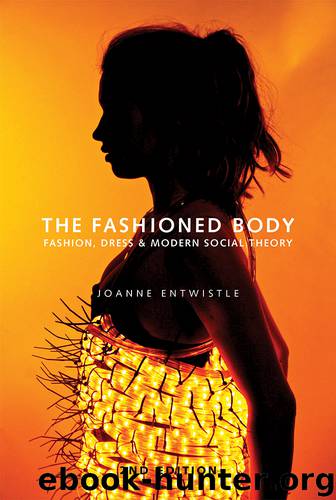The Fashioned Body by Joanne Entwistle

Author:Joanne Entwistle
Language: eng
Format: epub
ISBN: 9780745689395
Published: 2015-02-16T00:00:00+00:00
Fashion and Authenticity
While some adopted disguise and artifice as methods of ‘hiding’, this posed problems for others: how could one be sure of the veracity of the people one encountered? As Sennett (1977) argues, until around the mid-eighteenth century the problem of the veracity of appearances produced congenial sociability and one accepted the other at face value; in the nineteenth century it produced suspicion and unease. The ‘intimate society’ of the nineteenth century sought to probe beneath the appearance, to find the ‘inner truth’ of the ‘other’. This attitude encouraged the idea that if there is an inner reality, then it should relate to one’s outer appearance. As Sennett notes, ‘when street clothes and stage costume come to be seen as having something to do with the body, as they did with house clothing of the mid-eighteenth century, they will also come to appear to have something to do with the character of the person wearing them’ (1977: 72).
In other words, as clothing began to connect more closely to the body and individuality of the wearer, it was read for its ‘authenticity’. Arguably, the pressure of clothing to reveal the ‘authentic’ intentions of the wearer was greater for women in the nineteenth century who, according to Halttunen (1982), were constructed as the moral guardians of Protestant, bourgeois culture and therefore had to be ‘honest’ and ‘true’. She argues that the connection between inner sentiment and outer appearance was most clearly articulated by advocates of ‘sentimental’ dress popular in the mid-nineteenth century. Sentimental dress, which threw off the excessive decoration apparent in female dress from 1815 to the 1830s, drew attention to the body and face of the wearer: bonnets, for example were plain and simple and drew close to the head, so framing the face and its features.
The idea that character is immanent in appearance became increasingly popular in the nineteenth century, although the idea stretches back much further. The desire to find inner truth behind the mask of appearance is tied to the cult of Romanticism as much as it is tied to the rise of the urban bourgeoisie. Romanticism as a philosophical and aesthetic movement stretching back to the eighteenth century prioritizes the ‘natural’ over the social or cultural and challenges what it sees as the artifice and superficiality of appearances. In such a moral universe as this, dress and appearance are thought to reveal one’s ‘true’ identity; gone is the eighteenth-century idea that appearances within the public realm can act as a playful façade set at a distance from one’s intimate life. Romanticism encouraged a more psychological vision of self and society. It brought with it a new focus on individual uniqueness, explored in the work of philosopher Jean-Jacques Rousseau – a concern with the self which is narcissistic: ‘the Romantic is one who discovers himself as centre’ (Campbell 1989: 184). The Romantic strives for perfection, having found the world to be wanting, and the ‘conflict between sincerity and propriety solidifies into clear-cut opposition between self and
Download
This site does not store any files on its server. We only index and link to content provided by other sites. Please contact the content providers to delete copyright contents if any and email us, we'll remove relevant links or contents immediately.
| Advertising | Annuals |
| Book Design | Branding & Logo Design |
| Fashion Design | Illustration |
| Science Illustration |
Wonder by R.J. Palacio(7732)
Unlabel: Selling You Without Selling Out by Marc Ecko(2981)
POP by Steven Heller(2883)
Hidden Persuasion: 33 psychological influence techniques in advertising by Marc Andrews & Matthijs van Leeuwen & Rick van Baaren(2778)
The Pixar Touch by David A. Price(2739)
Ogilvy on Advertising by David Ogilvy(2682)
Drawing Cutting Edge Anatomy by Christopher Hart(2676)
Slugfest by Reed Tucker(2415)
The Art of War Visualized by Jessica Hagy(2412)
The Curated Closet by Anuschka Rees(2385)
Stacked Decks by The Rotenberg Collection(2270)
The Wardrobe Wakeup by Lois Joy Johnson(2234)
365 Days of Wonder by R.J. Palacio(2233)
The Code Book by Simon Singh(2209)
Rapid Viz: A New Method for the Rapid Visualization of Ideas by Kurt Hanks & Larry Belliston(2195)
Tell Me More by Kelly Corrigan(2195)
Keep Going by Austin Kleon(2160)
Tattoo Art by Doralba Picerno(2083)
Tokyo Geek's Guide: Manga, Anime, Gaming, Cosplay, Toys, Idols & More - The Ultimate Guide to Japan's Otaku Culture by Simone Gianni(1945)
